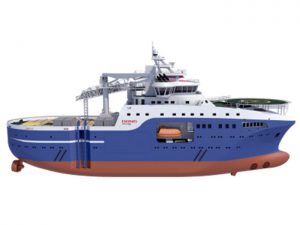
Hybrid wind farm SOV to have ABB Onboard DC Grid
AUGUST 22, 2017 — A diesel-electric offshore wind farm Service Operation Vessel (SOV) designed by Norway’s Salt Ship Design and being built for Louis Dreyfus Armateurs by Turkey’s Cemre Shipyard is to

AUGUST 22, 2017 — A diesel-electric offshore wind farm Service Operation Vessel (SOV) designed by Norway’s Salt Ship Design and being built for Louis Dreyfus Armateurs by Turkey’s Cemre Shipyard is to
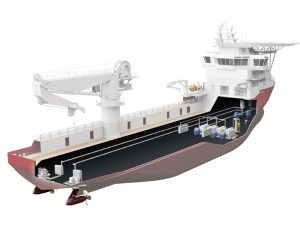
JUNE 16, 2014 — ABB has released the results of third-party measurements and tests verifying that its Onboard DC Grid helps vessels reduce their fuel consumption, cut noise and trim their environmental
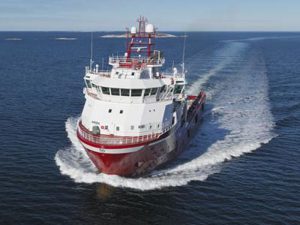
JANUARY 27, 2014 — ABS has granted Approval in Principal (AIP) to the ABB onboard DC grid power distribution system. ABB says that onboard DC grid,is one of the most flexible marine
APRIL 4, 2013 — Recently delivered to Myklebusthaug Offshore, Fonnes, Norway, by shipbuilder Kleven, the platform supply vessel Dina Star is the first vessel to feature ABB’s Onboard DC (direct current) Grid.
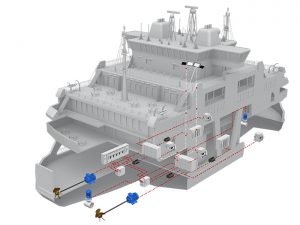
ABB has released a compact size DC-based power distribution system to offer hybrid power efficiencies to smaller vessels The newly launched Onboard Microgrid is based on the principles of ABB’s award-winning power
ABB has won an order from Norwegian shipowner Myklebusthaug Management to supply the first ever direct current (DC) power grid on board a ship. The equipment will allow a new offshore platform
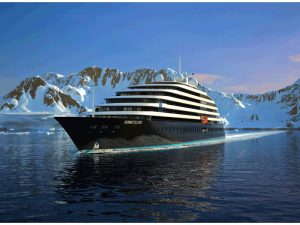
Soon, noon-day reporting from fallible human beings will be a thing of the past. From cradle to grave, a whole new approach to ship efficiency has been made possible by recent advances in IT and data processing. Now, a step change in “always-on” ship connectivity will allow maritime assets to be monitored and managed remotely right round the clock.
As we reported in “Shipping’s Space Age Future” (ML April 2016, p. 37), perhaps the most ambitious project on the go in Europe is the Rolls-Royce-led Advanced Autonomous Waterborne Applications Initiative (AAWAI) in which other maritime firms including DNV GL, Inmarsat, Deltamarin and NAPA are also involved. Other participants include top academics from various Finnish universities.
At a project update meeting recently in Helsinki, Rolls-Royce President – Marine, Mikael Makinen declared: “Autonomous shipping is the future of the maritime industry. As disruptive as the smart phone, the smart ship will revolutionize the landscape of ship design and operations.”
Delegates heard that the sensor technology is now sufficiently sound and commercially available so that algorithms required for robust decision-making—the vessel’s virtual captain—are not far away. Now the arrays of sensors are to be tested over the coming months on board Finferries’ 65-meter-long double-ended ferry, Stella.
“Some of the distinct goals of this project are to make a difference in marine safety and energy efficiency,” Päivi Haikkola, Manager, R&D, Deltamarin Ltd., told Marine Log. “We want to mitigate human error.”
Finferries and dry bulk shipping company ESL Shipping Oy are the first ship operators to join the project, which aims to explore ways in which to combine existing communication technologies as effectively as possible for autonomous ship control. Inmarsat’s involvement is key.
The London-listed communications company recently began the roll-out of its new Fleet Xpress service, seen by many as truly a light-bulb moment. Preparing the ground for rapid advances in smart ship operation and crew welfare, the new service now provides always-on high-speed broadband communication between maritime and offshore assets at sea, and shore-based managers. It is the first time that such a service has been available from a single operator.
Fleet Xpress will also facilitate cloud-based applications from third parties with smart systems to raise ship operating efficiency and improve the life-quality of seafarers. For the first time, big data can be used to improve asset management and maintenance.
IT advances have also facilitated a new approach to ship design. Model basins and testing tanks still have their place, of course, but thousands of relatively high-speed computational iterations can measure the relative benefits of small design changes in a way that has not been possible before.
Take the Finnish company Foreship, for example. Its capabilities in computational fluid dynamics (CFD) and the super-efficient hull forms which it has developed have propelled the company into a position as one of the top ship design consultants to global cruise lines, advising both on newbuilding plans, conversions and retrofits.
In a couple of months, the first of two 4,700 dwt “EcoCoaster” cargo ships is due for delivery to Finland’s Meriaura Group from the Royal Bodewes yard in the Netherlands. Foreship carried out extensive hull optimization work and, as a result, these vessels will burn only about half of the fuel compared to an existing vessel of similar size and class.
Foreship worked with both the owner and Aker Arctic Technology on the ships which will be able to run on biofuel or marine gasoil. Meriaura plans to have at least half of its fleet – currently about 20 ships – based on EcoCoaster designs by 2020. Since ordering the 4,700 dwt units, work has been carried out on larger designs.
Also hailing from Finland is progressive ship design firm Deltamarin. Now a subsidiary of Singapore-listed AVIC International Maritime Holdings Limited and ultimate Chinese ownership, the company’s range of super-efficient B.delta bulk carriers spanning a size range from 28,000 dwt to 210,000 dwt has caught the attention of long-established dry bulk owners including heavyweights such as Algoma, Canada Steamship, Cosco, Louis Dreyfus Armateurs and Oldendorff.
Of course the catalyst for taking a fresh look at the hull forms which had not changed for decades was the spike in bunker prices. But although the oil price collapse means today’s fuels cost only a fraction of prices two or three years ago, the search for improved economy has developed a momentum of its own, and nowhere is this more obvious than amongst leading propulsion companies, many of which are to be found in Europe.
While big low-speed diesel manufacturers like MAN Diesel & Turbo and Wärtsilä have made huge strides in raising the fuel efficiency of large engines, it is among some of the smaller niche machinery providers where true design innovation is to be found. Electrical power, energy storage and the growing popularity of azimuth thrusters are fiercely fought-after markets. ABB, Rolls-Royce, Steerprop, and Wärtsilä all feature in a market popular with operators of cruise ships, workboats, offshore support vessels and dynamically positioned offshore units of various types.
ABB, for example, recently won a European Marine Engineering Award for its Azipod D electric propulsion system with a power range from 1.6MW to 7MW. Launched last year, the latest Azipod was designed to allow its use on a wider range of ship types. It incorporates various innovative features including a new hybrid cooling system which contributes to a requirement for 25% less installed power and similar fuel savings.
The first cruise ship with Azipod D will be the 16,800 gt Scenic Eclipse being built by Uljanik shipyard in Croatia. The Scenic Eclipse (pictured above) is being built to Polar Class 6 and will operate in the summer waters of the Polar regions when it is delivered in 2018. The 228-passenger ship will have two 3MW Azipods installed.
Meanwhile, ABB recently announced a deal to supply a new electrical power system based on its Onboard DC Grid system for a hybrid car ferry in Norway. Initially the vessel, for Torghatten Trafikkselskap will operate as a hybrid with two battery packs contributing to peak demand. However, the 60-car, 250-passenger vessel can be easily modified to become fully electric in due course by adding 16 battery packs and a shore connection.
For the cruise ship and offshore vessel markets, Wärtsilä recently unveiled the Wärtsilä WTT-40 transverse thruster, which features a 4,000 kW power level and a 3,400 mm diameter controllable pitch propeller. The thruster complies with the U.S. EPA’s latest VGP2013 regulations. It also features integrated hydraulics to save machinery room space and installation and commissioning time in the shipyard.
Meanwhile, last year Steerprop Ltd. landed orders for a total of ten SP25D units to serve as main propulsion for three inland towboats being built for SCF Marine at C&C Marine & Repair, Belle Chasse, LA. The propulsors will be delivered this summer to the shipyard by Karl Senner, LLC., Kenner, LA, the North American distributor for Steerprop. These will be the largest and highest horsepower inland towboats equipped with Z-drives built in North America to date, according to Chris Senner of Karl Senner, LLC. He adds, “It is imperative to consider the harsh conditions of the inland waterways and select a unit suited for the environment, which is why we propose the equivalent of an ice-class rated unit.”
A new generation of much more fuel and operationally efficient newbuilds, however, does nothing for the tens of thousands of existing vessels built before the new wave of design innovation began. But there are a range of initiatives in progress focused on enhancing existing ship efficiency.
 Germany’s Becker Marine Systems is a leading light in energy-efficient retrofits and appendages. The company recently signed a deal with Abu Dhabi’s Adnatco to fit some 20 vessels with Becker Mewis Ducts (pictured at right). Rudder modifications and Becker Twisted Fins are also generating a steady pipeline of sales.
Germany’s Becker Marine Systems is a leading light in energy-efficient retrofits and appendages. The company recently signed a deal with Abu Dhabi’s Adnatco to fit some 20 vessels with Becker Mewis Ducts (pictured at right). Rudder modifications and Becker Twisted Fins are also generating a steady pipeline of sales.
Walter Bauer, Sales Director, concedes that sales volume has reduced. But he says that this is partly a result of the dire state of the bulk carrier market. Tanker business, he says, is holding up well.
But what to do with almost-obsolete panamax container ships? Owing to beam constraints, they are generally long and relatively thin, and were mostly built in an era of cheap fuel and fast sailing speeds. They are not particularly efficient from a box-carrying point of view, but are in dire straits today, competing with larger ships and lower slot costs. There are more than 800 such vessels in the world fleet today and well over half are less than 10 years old. They are likely to prove increasingly unpopular with charterers.
Cargo access specialist MacGregor is one of several companies which offers capacity increasing conversions for container ships. By slicing a vessel in half lengthways, a newly constructed midship section can be inserted and stack heights raised by lifting the navigation bridge.
In a similar project, the capacity of the 4,860 TEU MSC Geneva, owned by Reederei NSB, was increased to 6,300 TEU. The five-month widening project, undertaken in close cooperation with Hamburg’s Technology GmbH, was completed at Huaran Dadong Dockyard in China. Through its subsidiary NSB Marine Solutions, Reederei NSB is now offering to assist in similar projects for third parties.
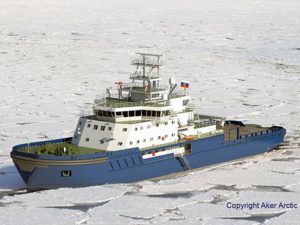
Designed by Aker Arctic, the icebreaker will support LNG carriers’ operability in the approach channel to the Sabetta harbor and in the terminal at Sabetta. With a length of 89.5 m, draft of 6.5 m and 12 MW propulsion power, it has been designed to proceed at a speed of two knots in level ice 1.5 m thick and at four knots in 5 m thick brash ice in limited water depth.
ABB will provide the power, automation and turbocharging capabilities for the vessel, which will maximize fuel efficiency and maneuverability by including four Azipod thrusters, adapted for the tough ice conditions and ABB’s DC Grid system, to distribute energy effectively. The main engine will also be fitted with a Power2 800-M advanced two-stage turbocharging system, enabling the highest efficiency turbocharging performance.
Peter Terweisch, ABB Group Senior Vice President, Process Automation says, “ABB’s marine applications are at the forefront of the icebreaking market with our process automation technology now central to the world’s most advanced icebreaking vessel. We are very pleased to be able to deliver industry leading levels of efficiency and safety by providing so many ABB latest generation solutions on one vessel.”
The vessel’s ABB Onboard DC Grid systemhas many advantages. It provides space and weight savings whilst minimizing noise and vibration. A key advantages is that it allows diesel engines to run at variable speeds, rather than one fixed speed, is important when managing ice conditions. This flexibility can also cut fuel use and emissions.
Two pairs of Azipod thrusters will be fitted on the bow and stern of the ship, all of which will be adapted to the conditions. They will be equipped with powerful electric motors (3 MW each). Turning 360 degrees, they will allow the ship’s crew to maneuver the vessel to operate stern or bow first.
Aker Arctic’s Mika Hovilainen says “The harbor icebreaker is a totally new concept especially developed for heavy harbor ice conditions with extensive thick brash ice. Having four Azipod units helps to take operability, maneuverability and ice management capability to one step further. Along with ABB Marine and Ports, we continue to be at the cutting edge of icebreaking technology.”
The icebreaker’s ABB Integrated Power and Energy Management System and Marine Automation System bring together main elements of the ship’s performance, such as power generation and propulsion, into a centralized system allowing the operator to increase efficiency and safety.
The Power2 800-M two-stage turbocharging system on the icebreaker’s Wärtsilä 31 engine, will further enhance fuel efficiency and flexibility of operations. With a low pressure and high pressure stage, it provides higher air pressure ratios, up to 12 from 8 in the previous generation. Compared to a single-stage turbocharger operating at 65-70% efficiency, Power2 800-M goes beyond 75% efficiency, the only system currently available across the large engine industry with this capability.
The turbocharging system responds to the need for new marine engine technology to offer consistency of performance across conventional and newer marine fuel options. This application will demonstrate the advances in efficiency and power density now available for four-stroke engines operating across a wide range of load profiles and facing added demands of emissions legislation.

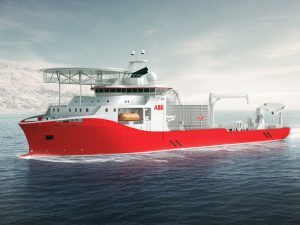
The vessel will be custom built to ABB specifications, with Norway’s Salt Ship Design working closely with ABB, the shipyard and MAATS Tech of the U.K., which is responsible for the integration of the cable lay mission equipment in the design development. The resulting SALT 306 design, says Salt, is “very comprehensive and fit for purpose.”
“This next-generation vessel incorporating state-of-the-art ABB technologies will be a key differentiator for our high-voltage cable business, enhancing flexibility and execution ability,” said Claudio Facchin, president of ABB’s Power Systems division. “It will also improve operational efficiency and customer focus, supporting profitable growth in line with our Next Level strategy.”
The new ship will deploy many of ABB’s own leading marine technologies. The award-winning Onboard DC Grid and power distribution solution, for instance, will use a single DC circuit for ship propulsion to reduce power consumption.
The vessel will set new standards for reliability and accuracy and will be equipped with roll-reduction tanks and the subsea operations will be executed and monitored by a remotely operated vehicle using cameras and sonar, avoiding the need for divers.
The vessel will also feature a complete ABB Integrated Automation System and three Azipod propulsion units. Together with an energy storage system for marine applications it will cut fuel consumption by 27 percent and reduce maintenance compared to traditional AC systems.
Sensors, monitoring hardware and software will enable data to be sent to shore via a satellite link, to allow the onshore technical support centers to work closely with the ship as part of ABB’s Integrated Marine Operations solution. Advanced advisory software for motion monitoring, forecasting and decision support will also be on board.
Thanks to dynamic positioning technology to DP3 class, the ship will be able to maintain its position with a high precision.
It is constructed in such a way that fire and flooding can be contained and will not compromise positioning and other essential systems.
With experience dating back to 1883, ABB is a global leader in high-voltage cable systems with an installed base across applications such as integration of renewables, city center in-feeds, oil and gas platform power supplies, and subsea interconnections. ABB has commissioned more than 25 high-voltage direct current links and hundreds of high-voltage alternating current links around the world.


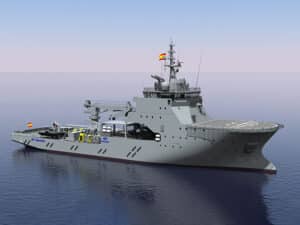
The Spanish Navy is to get a new submarine rescue vessel to replace its current 46-year old vessel, the Neptune, originally launched as a tugboat in 1945. The Spanish Navy is currently